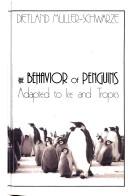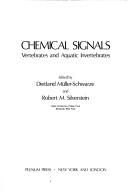| Listing 1 - 10 of 16 | << page >> |
Sort by
|
Book
ISBN: 1441903771 9786612970696 1282970690 144190378X Year: 2009 Publisher: New York, NY : Springer New York : Imprint: Springer,
Abstract | Keywords | Export | Availability | Bookmark
 Loading...
Loading...Choose an application
- Reference Manager
- EndNote
- RefWorks (Direct export to RefWorks)
Hands-On Chemical Ecology: Simple Field and Laboratory Exercises, a premiere collection of practical exercises in chemical ecology, offers tools and strategies for understanding this young science. The exercises included use general principles and follow a simple structure. Topics examined include birds, fish, insects, mammals, and plant chemistry among others. Additionally, exercises require accessible materials, ensuring that each can be easily modified and completed anywhere in the world with locally existing instruments. This text will be of value to undergraduate and graduates students and high school biology teachers. About the Author: Professor Dietland Müller-Schwarze has published Chemical Ecology of Vertebrates (Cambridge University Press 2006), co-edited 10 volumes of "Chemical Signals in Vertebrates" (Plenum Press), and written nearly 200 research papers in the field of chemical ecology. For several years, he has taught "Introduction to Chemical Ecology," an undergraduate course, and "Chemical Ecology of Vertebrates," a graduate course, at the State University of New York’s College of Environmental Science and Forestry. Dr. Müller-Schwarze has also been a member of the Editorial Board of the Journal of Chemical Ecology for 27 years.
Chemical ecology. --- Chemical ecology -- Problems, exercises, etc. --- Ecology. --- Chemical ecology --- Earth & Environmental Sciences --- Ecology --- Chemoecology --- Life sciences. --- Chemistry. --- Plant ecology. --- Animal physiology. --- Invertebrates. --- Entomology. --- Life Sciences. --- Chemistry/Food Science, general. --- Plant Ecology. --- Animal Physiology. --- Metabolites --- Animal physiology --- Animals --- Biology --- Anatomy --- Insects --- Zoology --- Invertebrata --- Botany --- Plants --- Physical sciences --- Balance of nature --- Bionomics --- Ecological processes --- Ecological science --- Ecological sciences --- Environment --- Environmental biology --- Oecology --- Environmental sciences --- Population biology --- Physiology --- Phytoecology --- Vegetation ecology --- Ecology . --- Floristic ecology

ISBN: 9781107406933 9780521363778 0521363772 9780511607233 9780511242052 0511242050 0511240902 9780511240904 0511241429 9780511241420 0511241925 9780511241925 0511607237 1280567775 9781280567773 1107406935 1107157056 9786610567775 051131812X Year: 2006 Publisher: Cambridge Cambridge University Press
Abstract | Keywords | Export | Availability | Bookmark
 Loading...
Loading...Choose an application
- Reference Manager
- EndNote
- RefWorks (Direct export to RefWorks)
Published in 2006, Chemical Ecology of Vertebrates was the first book to focus exclusively on the chemically-mediated interactions between vertebrates including fish, amphibians, reptiles, birds and mammals, and other animals and plants. Reviewing research in three core areas - pheromones (where the interactions are between members of the same species), interspecific interactions involving allomones (where the sender benefits) and kairomones (where the receiver benefits), it pulls together information from widely scattered technical literature in many different disciplines into a coherent whole. Chapters on the environment, properties of odour signals, and production and release of chemosignals set the stage for discussion of more complex behavioural topics. While the main focus is ecological, dealing with behaviour and interactions in the field, it also covers chemoreception, orientation and navigation, the development of behaviour and the practical applications of chemosignals.
Vertebrates --- Animal ethology and ecology. Sociobiology --- Chemical ecology --- Ecologie chimique --- Vertebrata --- Chordata --- Chemical ecology. --- Chemoecology --- Chemosensory ecology --- Ecology --- Metabolites --- Ecology.

ISBN: 0585061211 9780585061214 1438413866 0873958667 0873958675 9781438413860 Year: 1984 Publisher: Albany State University of New York Press
Abstract | Keywords | Export | Availability | Bookmark
 Loading...
Loading...Choose an application
- Reference Manager
- EndNote
- RefWorks (Direct export to RefWorks)
Book
ISBN: 0801460867 9780801460869 9780801450105 0801450101 Year: 2011 Publisher: Ithaca, NY
Abstract | Keywords | Export | Availability | Bookmark
 Loading...
Loading...Choose an application
- Reference Manager
- EndNote
- RefWorks (Direct export to RefWorks)
The Beaver: Its Life and Impact is designed to satisfy the curiosity and answer the questions of anyone with an interest in these animals, from students who enjoy watching beaver ponds at nature centers to homeowners and land managers. Color and black-and-white photographs document every aspect of beaver behavior and biology, the variety of their constructions, and the habitats that depend on their presence.A second edition of The Beaver: Ecology and Behavior of a Wetland Engineer, published by Cornell University Press under its Comstock Publishing Associates imprint in 2003, this book has been revised throughout and includes a new section on population genetics and features updated data about the beaver's range in North America, reintroduction efforts in Europe, and information about the world's largest beaver dam, discovered in northern Alberta in 2010 and visible from space, as well as the most current bibliography on the subject.As this book shows, the beaver is a keystone species-their skills as foresters and engineers create and maintain ponds and wetlands that increase biodiversity, purify water, and prevent large-scale flooding. Biologists have long studied their daily and seasonal routines, family structures, and dispersal patterns. As human development encroaches into formerly wild areas, property owners and government authorities need new, nonlethal strategies for dealing with so-called nuisance beavers. At the same time, the complex behavior of beavers intrigues visitors at parks and other wildlife viewing sites because it is relatively easy to observe.
Beavers. --- Beaver --- Castor (Mammals) --- Castoridae --- Castorids --- Rodents
Book
ISBN: 0879332727 Year: 1978 Publisher: Stroudsburg Dowden, Hutchinson and Ross
Abstract | Keywords | Export | Availability | Bookmark
 Loading...
Loading...Choose an application
- Reference Manager
- EndNote
- RefWorks (Direct export to RefWorks)
Play --- Psychology, Comparative --- Play and Playthings --- 159.92 --- Comparative Psychology --- Comparative Psychologies --- Psychologies, Comparative --- Playthings --- Puppets --- Toys --- Plays --- Plaything --- Playthings and Play --- Puppet --- Toy --- 159.92 Geestelijke ontwikkeling en vermogen. Ontwikkelingspsychologie --- Geestelijke ontwikkeling en vermogen. Ontwikkelingspsychologie --- Behavior, Comparative --- Comparative behavior --- Comparative psychology --- Ethology, Comparative --- Intelligence of animals --- Zoology --- Animal behavior --- Animal intelligence --- Animal psychology --- Human behavior --- Instinct --- Recreations --- Recreation --- Amusements --- Games
Digital
ISBN: 9781441903785 Year: 2009 Publisher: New York, NY Springer-Verlag New York
Abstract | Keywords | Export | Availability | Bookmark
 Loading...
Loading...Choose an application
- Reference Manager
- EndNote
- RefWorks (Direct export to RefWorks)
General ecology and biosociology --- Animal physiology. Animal biophysics --- Invertebrates --- Insects. Springtails --- systematische plantkunde --- invertebraten --- fysiologie --- ecologie --- zoölogie --- insecten --- proefdieren

ISBN: 0306403390 Year: 1980 Publisher: New York
Abstract | Keywords | Export | Availability | Bookmark
 Loading...
Loading...Choose an application
- Reference Manager
- EndNote
- RefWorks (Direct export to RefWorks)
Book
ISBN: 0306310325 1468423665 1468423649 9780306310324 Year: 1977 Publisher: New York (N.Y.): Plenum
Abstract | Keywords | Export | Availability | Bookmark
 Loading...
Loading...Choose an application
- Reference Manager
- EndNote
- RefWorks (Direct export to RefWorks)
Chemical senses --- Animal communication --- Pheromones --- Vertebrates --- Animal Communication --- Sensation --- Congresses --- Physiology --- congresses --- physiology --- -Pheromones --- -Vertebrates --- -#Lilly --- Vertebrata --- Chordata --- Hormones --- Semiochemicals --- Sex recognition (Zoology) --- Chemoreception --- Senses and sensation --- Chemoreceptors --- Congresses. --- -Congresses --- congresses. --- #Lilly --- Physiology&delete& --- Animal communication - Congresses --- Chemical senses - Congresses --- Vertebrates - Physiology - Congresses --- Pheromones - Congresses
Book
ISBN: 9781441903785 9781441903778 Year: 2009 Publisher: New York, NY Springer-Verlag New York
Abstract | Keywords | Export | Availability | Bookmark
 Loading...
Loading...Choose an application
- Reference Manager
- EndNote
- RefWorks (Direct export to RefWorks)
Hands-On Chemical Ecology: Simple Field and Laboratory Exercises, a premiere collection of practical exercises in chemical ecology, offers tools and strategies for understanding this young science. The exercises included use general principles and follow a simple structure. Topics examined include birds, fish, insects, mammals, and plant chemistry among others. Additionally, exercises require accessible materials, ensuring that each can be easily modified and completed anywhere in the world with locally existing instruments. This text will be of value to undergraduate and graduates students and high school biology teachers. About the Author: Professor Dietland Müller-Schwarze has published Chemical Ecology of Vertebrates (Cambridge University Press 2006), co-edited 10 volumes of "Chemical Signals in Vertebrates" (Plenum Press), and written nearly 200 research papers in the field of chemical ecology. For several years, he has taught "Introduction to Chemical Ecology," an undergraduate course, and "Chemical Ecology of Vertebrates," a graduate course, at the State University of New York's College of Environmental Science and Forestry. Dr. Müller-Schwarze has also been a member of the Editorial Board of the Journal of Chemical Ecology for 27 years.
General ecology and biosociology --- Animal physiology. Animal biophysics --- Invertebrates --- Insects. Springtails --- systematische plantkunde --- invertebraten --- fysiologie --- ecologie --- zoölogie --- insecten --- proefdieren --- Chemical ecology
Article
Abstract | Keywords | Export | Availability | Bookmark
 Loading...
Loading...Choose an application
- Reference Manager
- EndNote
- RefWorks (Direct export to RefWorks)
Imprinting. --- Mammals. --- Olfactory. --- Precocial.
| Listing 1 - 10 of 16 | << page >> |
Sort by
|

 Search
Search Feedback
Feedback About UniCat
About UniCat  Help
Help News
News